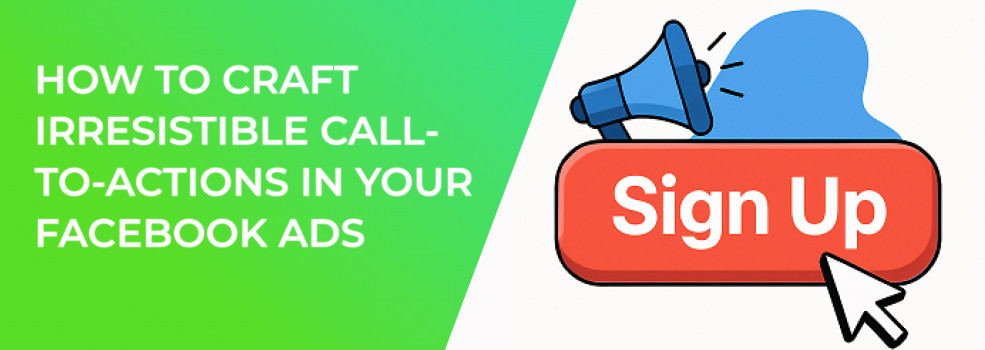When you scroll through Facebook, what finally convinces you to tap that bright blue button? In most cases it is a crisp, confidence-boosting call-to-action (CTA) that feels like it was written just for you. Yet despite CTAs being the tipping-point between a view and a conversion, many advertisers still treat them as an after-thought. If your average click-through rate on Facebook ads is stuck in neutral, sharpening your CTA is the fastest way to get moving again.
Running into the dreaded delivery warning? Read why you see “Ad Set May Get Zero” on Facebook and how to fix it before you tweak another button.
Why Your CTA Quietly Controls Facebook Ad Performance
Your image can sparkle and your targeting can be razor-sharp, but without a magnetic CTA your Facebook ads conversion rate will stall. A compelling CTA completes three jobs in the blink of an eye:
-
Clarifies value by spelling out exactly what happens next.
-
Creates urgency by nudging people to act now rather than “someday.”
-
Reduces friction by making the next step feel safe and simple.
Marketers who consistently push their Facebook ad click-through rate above 1.5 percent often attribute more of their success to fine-tuning CTAs than to swapping creatives or rewriting headlines.
Before we dive into mechanics, remember that a CTA is more than just copy on a button. It is the final handshake between your offer and the user’s intent. Treating it with that level of respect sets you up for the optimization wins that follow.
Anatomy of an Irresistible CTA Button
Below are proven elements that go into a high-performing CTA. Read each point, then picture how it would look inside your own ads.
The four design pillars of a click-worthy CTA.
-
Verb-first copy: Open with strong, specific action words such as “Download Your Guide,” “Book a Demo,” or “Get 20 % Off.”
-
Specific payoff: Highlight the benefit the user receives, not the action itself. “See Pricing” is clearer than “Learn More.”
-
Contrast and whitespace: Choose a button color that pops against the background while still respecting Facebook’s 20 percent text rule.
Button shapes and sizes change across placements, so skim this guide to every Facebook ad format when you’re choosing colors and dimensions. -
Mobile mindfulness: Size and placement should be comfortable for thumbs; avoid edges that require finger gymnastics.
These tweaks may seem small at first glance. Over hundreds of impressions, however, they chip away at wasted spend, lower your FB pay-per-click cost, and inch your Facebook ads average conversion rate higher with every campaign.
After implementing any of these changes, give your campaign at least 72 hours to collect statistically meaningful data before you judge performance. Patience prevents false positives and saves budget in the long run.
Writing Copy That Makes People Tap “Yes”
Great CTAs combine psychology and precision. To illustrate, here is a short table of copy formulas that routinely outperform generic “Click Here” buttons. Read the examples, imagine how they could frame your unique offer, and then test a few inside Ads Manager.
Why do these phrases work? They remove ambiguity, promise a concrete outcome, and neutralize the reader’s fear of wasting time or money. After adding any new copy variant, monitor “Outbound CTR” and “Cost per Result” to verify that the nicer words also earn nicer numbers.
Design and Placement Tips to Optimize Conversions
Now that your copy is locked in, let us talk design. Even stellar wording can be crushed by a clumsy layout. Use the next checklist as a quick tune-up, then circle back to test each tweak one at a time.
-
Above-the-fold placement: On mobile, make sure the CTA sits within the upper 20 percent of the visual frame so it appears before users scroll.
-
Directional cues: Subtle arrows or short animations can guide the eye without violating Facebook policies.
-
Color psychology: Urgent reds often win for flash sales, while high-contrast blues or greens convert well in B2B niches. Your audience decides; your job is to test.
-
One CTA per ad: Multiple buttons dilute focus and confuse the algorithm, reducing the chance of hitting your maximum conversion potential.
Do a quick audit of your active campaigns. If any single creative breaks more than one of these rules, pause it, fix the layout, and relaunch. You will often see faster gains than by raising budget alone.
Test, Track, Tweak: Making Data-Driven Decisions
Even the most persuasive theory needs proof. Here is a three-step loop for validating every CTA change:
-
Baseline your metrics
Look at historical “Outbound CTR” and “Conversions” in Ads Manager. If you are unsure what a good click-through rate for Facebook ads looks like in your industry, aim for at least one percent as a starting benchmark.
If your outbound CTR is still under one percent, work through the checkpoints in this CTR troubleshooting playbook next. -
Run controlled split tests
Use Facebook’s built-in A/B tool to isolate one variable at a time — copy, button color, or placement. This scientific approach embodies true Facebook ad optimization. -
Map results to revenue
A higher CTR is meaningless if it does not translate to sales. Compare each variant’s cost per purchase, value per conversion, and lifetime value to see which button actually moves profit.
A killer click-through rate means nothing without sales — see why some Facebook ads don’t convert and how to turn them around if the numbers stall.
If a winning variant emerges, do not stop there. Move to a fresh test immediately, because audience fatigue can erode gains faster than you think.
Advanced Moves for Ambitious Advertisers
Once your basic CTAs outperform the control, consider levelling up with advanced tactics:
-
Dynamic CTAs powered by your product catalog switch text automatically, for example “Book Now” versus “Pre-Order,” depending on inventory status.
-
Sequential retargeting warms cold traffic with soft CTAs like “Learn More,” then shows harder prompts such as “Buy Now” to people who already engaged.
-
Messenger and WhatsApp buttons open a conversation instead of a landing page, compressing the sales cycle for products that need human interaction.
Dynamic CTAs sync with inventory to stay relevant and timely.
Each technique requires its own mini-test plan, so resist the urge to launch them all at once. Layer them gradually to keep data clean.
When performance suddenly slips, rule out creative burnout with these quick ad-fatigue checks before rewriting yet another CTA.
Your Next Steps
A great CTA is half science, half empathy. When you see it as the micro-moment that decides whether someone joins your list, books a demo, or abandons your funnel forever, you will treat every word and pixel with the care it deserves. Yes, Facebook’s algorithm evolves, but human psychology does not. Clear value, low friction, and a gentle push remain the timeless ingredients of conversion.
Ready to apply what you have learned? Open Ads Manager, pick one active campaign, and improve the CTA using at least one idea from this article. Set a seven-day test window, watch the metrics, and let the numbers tell the story.
Happy scaling, and may your next button be the one that crushes your previous record!

